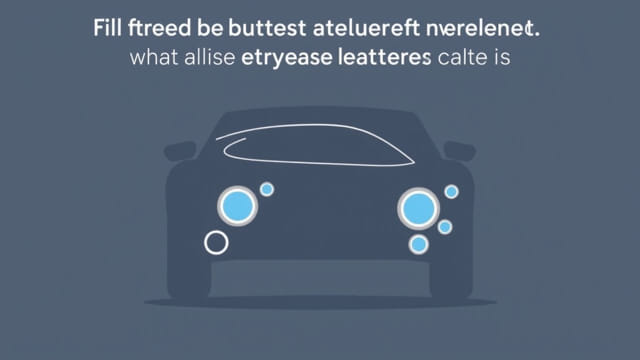Detecting an exhaust leak early is crucial for both vehicle performance and driver safety. If left unnoticed, leaks in the exhaust system can lead to poor fuel efficiency, increased emissions, and potential exposure to harmful gases like carbon monoxide. One simple yet effective method to identify such leaks involves using something as common as soapy water. This approach is especially useful for DIY car enthusiasts or anyone looking to diagnose exhaust issues without expensive tools. By applying soapy water and observing bubble formation, you can pinpoint problem areas in your exhaust system with surprising accuracy.
Understanding the Role of the Exhaust System
Importance of a Sealed Exhaust
The exhaust system is responsible for directing harmful gases away from the engine and out of the vehicle. It helps reduce engine noise, manage emissions, and ensure the vehicle operates efficiently. A leak compromises all of these functions, making it vital to identify and fix any issues promptly.
Common Causes of Exhaust Leaks
- Rust or corrosion in the exhaust pipes or muffler
- Cracks in the manifold or gaskets
- Loose connections or worn-out clamps
- Damage from road debris or impact
Signs of an Exhaust Leak
Before using the soapy water method, it helps to recognize symptoms that suggest a leak in your exhaust system. These signs may include:
- Loud rumbling or hissing noise while the engine is running
- Decreased fuel economy
- Strong smell of exhaust fumes inside the cabin
- Engine warning light, especially related to emissions
- Visible soot around joints or flanges
Preparing for the Soapy Water Test
Safety First
Working with the exhaust system requires caution. Exhaust components can become extremely hot, especially after running the engine. Allow the engine to cool completely before attempting this test. Additionally, conduct the procedure in a well-ventilated or open space to avoid inhaling any residual fumes.
What You Need
Gather the following materials before starting:
- Spray bottle
- Liquid dish soap
- Water
- Protective gloves and safety glasses
- Jack and jack stands (if extra clearance is needed)
Mixing the Soapy Water Solution
Create your solution by mixing a generous amount of liquid dish soap with warm water in a spray bottle. The solution should be bubbly enough to form visible foam when agitated. A good rule of thumb is to use one part soap to four parts water. Shake or stir until well mixed.
Performing the Leak Test
Step-by-Step Instructions
- Start by ensuring the engine is completely cool.
- Lift the vehicle with a jack and secure it using jack stands if necessary. Never work under a car supported only by a jack.
- Identify key areas of the exhaust system to inspect: the exhaust manifold, downpipe, catalytic converter, muffler, and tailpipe.
- Start the engine and let it idle. Be cautious of moving parts and hot surfaces.
- Spray the soapy water directly onto all exhaust joints, welds, and suspect areas.
- Observe the sprayed sections closely. If bubbles form or expand continuously, it’s a clear sign of an exhaust leak at that location.
- Turn off the engine and mark the leak areas for repair or further inspection.
Tips for Best Results
- Use a flashlight to see clearly under the vehicle, especially in low-light environments.
- If the leak is small, try listening for hissing sounds along with checking for bubbles.
- You may repeat the test with slightly higher engine revs for increased exhaust pressure, but only if it’s safe to do so.
- Check all clamps and flanges, even if they appear secure small cracks can be hard to detect without the bubble test.
What to Do After Finding the Leak
Temporary Fixes
If you find a leak but cannot fix it immediately, you may use high-temperature exhaust tape or sealant as a temporary measure. These materials can provide a short-term solution but should not be considered permanent repairs.
Permanent Repairs
Depending on the location and severity of the leak, permanent fixes might include:
- Replacing a damaged gasket or flange
- Welding cracks or holes in the pipe
- Installing a new section of pipe or muffler
- Tightening or replacing loose clamps
Professional mechanics can also run diagnostic tests to confirm leak locations and ensure your exhaust system meets emissions standards.
Why Soapy Water is a Practical Solution
Cost-Effective and Accessible
Using soapy water to find an exhaust leak is a budget-friendly technique that doesn’t require any specialized automotive tools. It is ideal for DIY inspections and gives reliable visual confirmation of small leaks.
Non-Invasive
This method doesn’t involve disassembling parts of the exhaust system or introducing chemicals that could damage components. It is safe for use on metal surfaces and rubber gaskets.
Quick and Reproducible
The soapy water test can be repeated easily after making repairs to confirm that the leak has been resolved, making it useful for both detection and follow-up verification.
Limitations of the Soapy Water Method
While this method is effective for visible and accessible parts of the exhaust system, it may not work as well for internal leaks or areas that are hard to reach. For example, leaks in the exhaust manifold or catalytic converter internals might require more advanced diagnostic tools, such as smoke machines or OBD-II readers.
Finding an exhaust leak with soapy water is a simple, safe, and effective method for identifying issues in your vehicle’s exhaust system. This low-cost technique provides visual confirmation of leaks and helps prevent further damage or exposure to harmful gases. Regular checks and maintenance of your exhaust system ensure your car remains efficient, quiet, and safe to operate. Whether you are a seasoned mechanic or a beginner tackling your first DIY inspection, using soapy water is a practical and accessible solution worth having in your toolkit.
